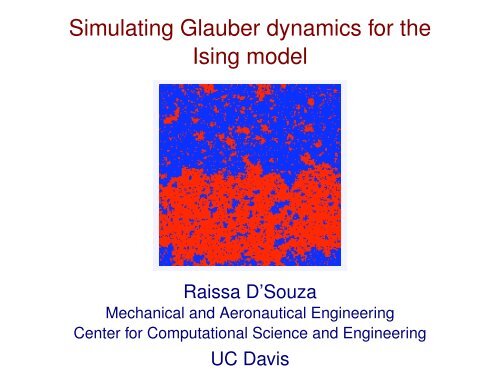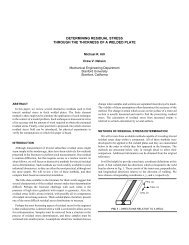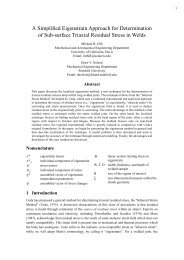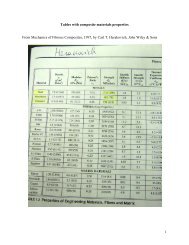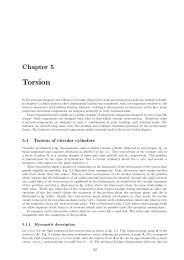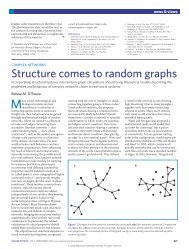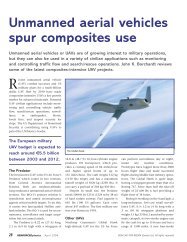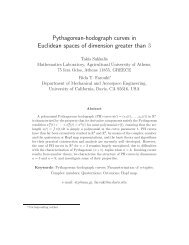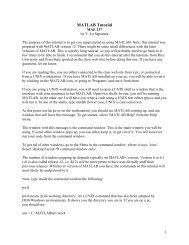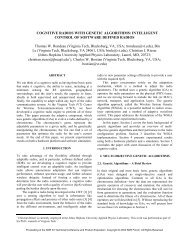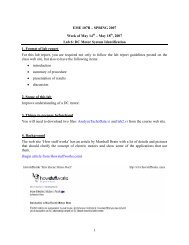Simulating Glauber dynamics for the Ising model
Simulating Glauber dynamics for the Ising model
Simulating Glauber dynamics for the Ising model
Create successful ePaper yourself
Turn your PDF publications into a flip-book with our unique Google optimized e-Paper software.
<strong>Simulating</strong> <strong>Glauber</strong> <strong>dynamics</strong> <strong>for</strong> <strong>the</strong><br />
<strong>Ising</strong> <strong>model</strong><br />
Raissa D’Souza<br />
Mechanical and Aeronautical Engineering<br />
Center <strong>for</strong> Computational Science and Engineering<br />
UC Davis
Why is it that many materials exhibit “spontaneous<br />
magnetization”?<br />
• At low temperatures, <strong>the</strong>y are magnetic.<br />
• At high temperatures, <strong>the</strong>y are not.
Electron “spins” and magnetization<br />
• W. Lenz (1920) proposed a <strong>model</strong> of ferromagnetism. That<br />
each electron possesses a “spin”. Parallel spins attract.<br />
Antiparallel spins repel. At sufficiently low temperatures, <strong>the</strong><br />
spins should align.<br />
• Ernst <strong>Ising</strong> (1924), in his doctoral <strong>the</strong>sis advised by Lenz,<br />
<strong>for</strong>malized <strong>the</strong>se ideas and examined a 1-D chain of such<br />
spins.<br />
si ∈ {−1, +1}<br />
Ei ∝ −sisj<br />
<strong>the</strong> “exchange energy”
• Consider a 2-D lattice.<br />
The “<strong>Ising</strong>” <strong>model</strong><br />
• At each site is a spin, si ∈ {−1, +1}.<br />
• Spins interact only with nearest neighbors.<br />
• There can be an external field h.<br />
• Thus <strong>the</strong> energy <strong>for</strong> each spin, Ei:<br />
Ei = − <br />
Jijsisj − hsi<br />
{sj}
Total energy, <strong>the</strong> “Hamiltonian”<br />
H = − <br />
〈i,j〉<br />
Jijsisj − <br />
• The first sum is over all nearest neighbor pairs.<br />
i<br />
hsi<br />
• Jij is <strong>the</strong> coupling between spins. We take Jij = J = 1.<br />
• Set external field h = 0 (if not, hysteresis).<br />
– Hysteresis enables magnetic storage of data.<br />
– Avalanche phenomena in domain flipping.<br />
– Studied via Random Field <strong>Ising</strong> Models (RFIM).
• All spins “up” → M = 1.<br />
Magnetization, M<br />
M = 1<br />
N<br />
• All spins “down” → M = −1.<br />
<br />
i si
Phase transition in M as function of T<br />
• Peierls (1936), gave a non-rigorous proof that spontaneous<br />
magnetization must exist <strong>for</strong> <strong>the</strong> 2-D <strong>Ising</strong> <strong>model</strong>.<br />
• Onsager (1944), gave a complete analytic solution.<br />
Phase transitions and universality — more on this later!
How to simulate <strong>the</strong> <strong>Ising</strong> <strong>model</strong>?<br />
• Starting from any initial condition, we know <strong>the</strong> equilibrium<br />
value of <strong>the</strong> magnetization. It is a function only of Temperature.<br />
How do we get to equilibrium?<br />
→
Equilibrium<br />
• In equilibrium, Boltzmann probability:<br />
• Ei is energy of state i.<br />
• k is Boltzmann’s constant.<br />
• T is temperature.<br />
p(Ei) = e (−Ei/kT ) /z<br />
• z = <br />
i e−Ei/kT is <strong>the</strong> partition (i.e., generating) function.
Spin-flip algorithms<br />
“Monte Carlo”<br />
• Use a stream of random numbers to drive a stochastic process,<br />
in this case <strong>the</strong> generation of a succession of many states of<br />
<strong>the</strong> spin <strong>model</strong>.<br />
• For an L × L lattice, <strong>the</strong>re are 2 L×L states. (e.g., If L = 10,<br />
<strong>the</strong>re are 2 100 possible states).<br />
• Want to sample <strong>the</strong> phase space so that each state occurs with<br />
<strong>the</strong> same probability as its equilibrium probability.<br />
• Metropolis (1953) detailed balance ensures convergence to<br />
equilibrium.<br />
P (Si)P (Si → Sj) = P (Sj)P (Sj → Si)
Detailed balance<br />
P (Si)P (Si → Sj) = P (Sj)P (Sj → Si)<br />
P (Si→Sj)<br />
P (Sj→Si)<br />
in o<strong>the</strong>r words:<br />
= P (Sj)<br />
P (Si)<br />
= e−(Ej−Ei)/kT<br />
(Where <strong>the</strong> last equality follows from <strong>the</strong> Boltzmann probability).
<strong>Glauber</strong> <strong>dynamics</strong><br />
• P (Si → Sj) = e −Ej/kT /(e −Ej/kT + e −Ei/kT )<br />
= 1/(1 + e ∆Eji/kT )<br />
• Choose a spin a random.<br />
• Calculate <strong>the</strong> energy difference resulting if that spin were<br />
flipped: ∆E.<br />
• Transition probability: P (flip) = 1/(1 + e ∆E/kT ).<br />
• Generate a random number, X. If X < P (flip) accept.<br />
• Parameterize time such that one unit of time is N spin-flip<br />
attempts.
Implementing <strong>the</strong> <strong>Glauber</strong> <strong>dynamics</strong><br />
• Only a finite number (5) of possible energy changes.<br />
• Can pre-compute <strong>the</strong> probabilities, 1/(1 + e ∆E/kT ).
Simulations<br />
• High temperature (initial condition irrelevant)<br />
• Low temperature (initial condition “quenched”)<br />
• Critical temperature (???)
Issues<br />
• Critical slowing down (correlation length diverges), and so<br />
does <strong>the</strong> relaxation time....<br />
• The critical point is <strong>the</strong> most interesting, yet <strong>the</strong> hardest to<br />
access and pin down!
• “Top” copy all spin up, +1.<br />
A coupled <strong>dynamics</strong><br />
• “Bottom” copy all spin down, -1.
Greedy coupled <strong>dynamics</strong><br />
• Pick a lattice site, v, at random.<br />
• Calculate probability <strong>for</strong> spin sv to be +1 in <strong>the</strong> top, ptop.<br />
• Calculate probability <strong>for</strong> spin sv to be +1 in <strong>the</strong> bottom, pbot.
p(+) =<br />
Probabilities (as usual)<br />
e −E(+)β<br />
e −E(+)β + e −E(−)β
Dynamics<br />
• Generate a random number, X.<br />
• set sv to be blue if: X < pbot.<br />
• set sv to be green if: pbot < X < ptop.<br />
• set sv to be yellow if: X > ptop.
The coupled system<br />
Growth of coupling with time.
Online Resources<br />
<strong>Ising</strong> <strong>model</strong> simulation:<br />
• http://stp.clarku.edu/simulations/ising2d/<br />
• http://bartok.ucsc.edu/peter/java/ising/keep/ising.html<br />
Cluster-flip <strong>dynamics</strong>:<br />
• http://www.hermetic.ch/compsci/<strong>the</strong>sis/chap1.htm


